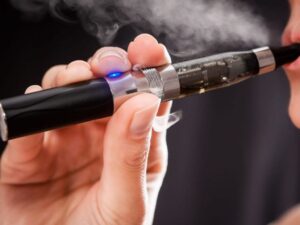Also see: DCC’s AB 1894 and new requirements for packaging, labeling, advertising, and marketing.
Beginning on July 1, 2024, Cal. Bus. & Prof. Code § 26152.1 will take effect, requiring:
• Advertisement and marketing of an integrated cannabis vaporizer, defined in Section 26122, shall prominently provide in a clear and legible fashion: “An empty integrated cannabis vaporizer shall be properly disposed of as hazardous waste at a household hazardous waste collection facility or other approved facility.”
• Advertisement and marketing of a cannabis cartridge shall prominently provide in a clear and legible fashion: “A spent cannabis cartridge shall be properly disposed of as hazardous waste at a household hazardous waste collection facility or other approved facility.”
• Advertisement and marketing [including, per DCC, packaging and labeling] of a cannabis cartridge and an integrated cannabis vaporizer shall not indicate that a cannabis cartridge or an integrated cannabis vaporizer is disposable nor imply that it may be thrown in the trash or recycling streams.
For the purposes of the new law section:
An “integrated cannabis vaporizer” is defined as: “a singular device that contains both cannabis oil and an integrated electronic device that creates an aerosol or vapor.”
A “cannabis cartridge” means a cartridge containing cannabis oil that is intended to be affixed to an electronic device that heats the oil and creates an aerosol or vapor.
“Authorized facility” means a facility authorized under the hazardous waste control laws under Chapter 6.5 (commencing with Section 25100) of Division 20 of the Health and Safety Code.
“Advertise” means the publication or dissemination of an advertisement.
“Advertisement” includes any written or verbal statement, illustration, or depiction which is calculated to induce sales of cannabis or cannabis products, including any written, printed, graphic, or other material, billboard, sign, or other outdoor display, public transit card, other periodical literature, publication, or in a radio or television broadcast, or in any other media (except labels, which are covered elsewhere).
“Advertising sign” is any sign, poster, display, billboard, or any other stationary or permanently affixed advertisement promoting the sale of cannabis or cannabis products which are not cultivated, manufactured, distributed, or sold on the same lot.
“Market” or “Marketing” means any act or process of promoting or selling cannabis or cannabis products, including, but not limited to, sponsorship of sporting events, point-of-sale advertising, and development of products specifically designed to appeal to certain demographics.
Cal NORML supports the proper disposal of cannabis vape pens, cartridges, and batteries.
Manufacturers, distributors, and retailers should make sure their packaging and advertising complies with the new law. The DCC says, “Licensees in possession of cannabis cartridges or integrated cannabis vaporizers that are packaged or labeled in a manner that doesn’t meet the requirements of AB 1894 should move the existing products through and out of the supply chain as quickly as possible. DCC plans to initially prioritize outreach and education to support increased compliance.”
Manufacturers and retailers should explore providing waste disposal programs for cannabis cartridges, vape pens, and batteries. The city of San Francisco provides battery collection buckets and information. Manufacturers (like Sauce and Plug Play) provide retailers with recycling bins for their products. Companies like GAIACA provide waste disposal programs for businesses.
Consumers should be aware of proper disposal options for cannabis cartridges and integrated cannabis vaporizers. A recycling facility in Santa Rosa saw three serious fires with millions of dollars in damages in the past month due to improper disposal of household batteries. Read more at: THE GREEN PUFF: TRANSFORMING CANNABIS VAPING INTO A SUSTAINABLE PRACTICE
Consumers: Check with your licensed cannabis retailer to see if they have a waste disposal program.
You can use this link to find an authorized hazardous waste facility near you.
Find Waste Management Locations.
Also see: How to Dispose of Vape Pen Batteries.
If All Else Fails…
If you live hundreds of miles away from any of these drop-off points and don’t want a pile of batteries building up (as they may catch fire), you will need to process the batteries yourself:
- Discharge each battery completely and allow them to cool.
- Submerge them in cold salt water for a full two weeks, covered with a secure lid.
- Wrap them in a newspaper and put them in the trash.
The aim of this process is to make the electrolyte fluid safe so that the batteries won’t explode or ignite. Remember that ignition is the main risk of improper disposal.
Treat your lithium-ion e-cigarette batteries just as you would your vape pen batteries. And if you have plastic e-liquid bottles (or liquid nicotine bottles) and cartridges for your e-cig, you can recycle those normally. Just make sure to first rinse any remaining residue from bottles.
Also see: Vaping Resources and Products
Find Cannabis Retailers that Support Cal NORML and Cannabis Consumers’ Rights
BACKGROUND
The law is the result of Assembly Bill 1894 (2022), which was introduced as a compromise following opposition from Cal NORML to another bill from the same author that would have banned disposable vape pens altogether. Instead, the proposal was amended to require a consumer advisory about how to properly dispose of them.
According to the bill’s author:
“To distinguish from the various electronic cigarette products (vapes) on the market, vapes in AB 1894 are defined as a one-time-use, cannabis-oil-filled device with an attached Lithium-ion battery (battery and cartridge in one). The major components of vapes pens are the battery, atomizer, e-liquid, cartridge, and aerosol. While vapes are made largely with recyclable materials, they contain elements of both universal waste including the electronic and the battery, and cannabis which is ‘special regulated waste.’
The wastes from vaping components creates significant environmental issues. Yet, there is no traditional recycling system to collect and properly manage cannabis vapes. While vapes are being marketed as disposable, they are not legally disposable. In order to educate consumers and prevent these vapes from going in the trash, we must stop the marketing of these products in any way that implies they can be disposed of in trash or recycling systems, and are clearly labeled to ensure the consumer is aware they must be disposed of as hazardous waste.”
According to the National Stewardship Action Council, sponsors of the bill,
“Vaping devices have become an increasingly popular method of consuming cannabis. Powered by a battery, these electronics are considered hazardous waste in California and banned from disposal in the trash or recycling. However, many brands instruct consumers to simply throw them away, which results in vapes being improperly disposed of in our materials management system where they have the potential to cause explosions and fires that can endanger people, expensive infrastructure, and the environment. These fires have become more commonplace in the industry, and operators are at risk of losing their insurance coverage.”




